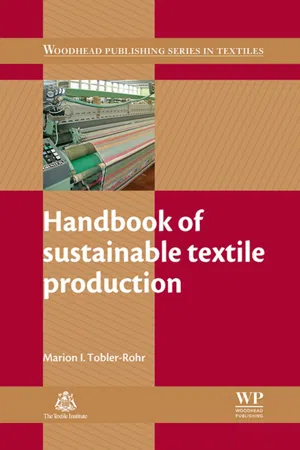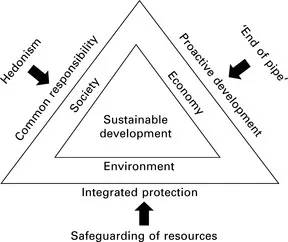
- 520 pages
- English
- ePUB (mobile friendly)
- Available on iOS & Android
eBook - ePub
Handbook of Sustainable Textile Production
About this book
Textile products are produced, distributed, sold and used worldwide. A quantitative assessment of sustainability in the textile manufacturing chain is therefore extremely important. The Handbook of sustainable textile production is a compilation of technical, economical, and environmental data from the various processes in this chain. This authoritative reference work provides a detailed study of the sustainable development of textiles.The book opens with an introduction to the topic. Chapters define the principles of sustainability and its use in legislation and industry before going on to investigate the impact of textiles throughout the supply chain, starting with the raw fibre through to fabric production, consumption and disposal. Textile process technology and methods for specifying quality and functions in textile products in order to reduce textile waste and improve sustainability are also examined. A series of Life Cycle Assessments (LCAs) carried out in the European textile industry are investigated. These studies comprise a range of processes from cotton growing, spinning and weaving to the recycling of textiles. The book concludes with a discussion on sustainable textiles from a product development and marketing perspective.With an internationally recognised expert author, the Handbook of sustainable textile production is a valuable reference tool for academics and students as well as for companies across the textile supply chain concerned with developing a sustainable environment, from fibre manufactures and designers to regulatory bodies.
- A detailed, quantitative assessment of the sustainable development of textiles
- Provides a useful compilation of technical, economical, and environmental data from various processes in the textile manufacturing chain
- Chapters define the principles of sustainability and its use in legislation and industry, textile process technology, the impact of textiles throughout the supply chain, raw fibre through to fabric production, consumption and disposal
Frequently asked questions
Yes, you can cancel anytime from the Subscription tab in your account settings on the Perlego website. Your subscription will stay active until the end of your current billing period. Learn how to cancel your subscription.
No, books cannot be downloaded as external files, such as PDFs, for use outside of Perlego. However, you can download books within the Perlego app for offline reading on mobile or tablet. Learn more here.
Perlego offers two plans: Essential and Complete
- Essential is ideal for learners and professionals who enjoy exploring a wide range of subjects. Access the Essential Library with 800,000+ trusted titles and best-sellers across business, personal growth, and the humanities. Includes unlimited reading time and Standard Read Aloud voice.
- Complete: Perfect for advanced learners and researchers needing full, unrestricted access. Unlock 1.4M+ books across hundreds of subjects, including academic and specialized titles. The Complete Plan also includes advanced features like Premium Read Aloud and Research Assistant.
We are an online textbook subscription service, where you can get access to an entire online library for less than the price of a single book per month. With over 1 million books across 1000+ topics, we’ve got you covered! Learn more here.
Look out for the read-aloud symbol on your next book to see if you can listen to it. The read-aloud tool reads text aloud for you, highlighting the text as it is being read. You can pause it, speed it up and slow it down. Learn more here.
Yes! You can use the Perlego app on both iOS or Android devices to read anytime, anywhere — even offline. Perfect for commutes or when you’re on the go.
Please note we cannot support devices running on iOS 13 and Android 7 or earlier. Learn more about using the app.
Please note we cannot support devices running on iOS 13 and Android 7 or earlier. Learn more about using the app.
Yes, you can access Handbook of Sustainable Textile Production by Marion I Tobler-Rohr in PDF and/or ePUB format, as well as other popular books in Biological Sciences & Environmental Science. We have over one million books available in our catalogue for you to explore.
Information
1
Sustainable development (SD) as a goal in production, marketing and trade
Abstract:
A brief overview on the multiple definitions and understanding of the term sustainable development is given: as a philosophy, as a scientific decision-making tool, but also as a belief of persons and policy to be applied in practice. It shows how theoretical concepts are translated and simplified into applications for authorities and the private sector. Some commonly used instruments like environmental management systems and labeling systems, environmental product declaration and eco design are introduced on how to identify, measure, quantify, and communicate environmental aspects in our everyday life and in science. Specific attention in this area is drawn to the textile sector.
Key words
sustainable development
environmental policy
environmental indicators
environmental management systems
eco labeling
This chapter is for managers developing SD marketing strategies, for politicians developing SD policy, and for authorities setting the framework for SD in the textile sector.
1.1 A holistic concept
Is ‘sustainable development’ an overstressed expression? It has become very trendy to use the term sustainability for underlining any turnaround leading to a ‘golden age’. Also it is generally agreed that ‘sustainable development’ (SD) characterizes a process towards a goal which cannot be defined very precisely. ‘Sustainable’ is often used synonymously with having a ‘serious intention’ or being ‘long lasting’. There is no way to prevent people from applying words and terms in their own language, whereby the meaning can be completely changed. Similar ambiguities can be found in the terms ‘environment’ (in economy or ecology) and ‘product life cycle’ (again in economy or ecology). Consequently the question arises whether the term ‘sustainable development’ should be replaced by another expression. This must be denied for three reasons: first, it will not be easy to find an acceptable term; second, a new term could be applied in a misleading way; and third, a long-lasting process like sustainable development should not be renamed while it is in action. But now: what is ‘sustainable development’ all about?
1.1.1 Sustainable development and its goals
The definition in the Brundtland report of the World Commission on Environment and Development, ‘… development that meets the needs of the present without compromising the ability of future generations to meet their own needs’, is still considered as one of the most accepted (Brundtland 1989), even if the expression is not very detailed, or perhaps exactly because it is so vague. Sustainable development describes in the most simple way a long-term strategy including economic, human (social) and environmental (material) resources. This means a threefold strategy: to run a business based on the return rates of a capital stock but never on the capital itself, to respect and apply the framework of human rights in society, and to use environmental resources within the Earth’s carrying capacity.
Today more than 200 definitions for SD can be found. Generally they all refer to the three pillars: economy, society and (ecological) environment, whereby the equivalent value of the pillars should be a goal, which certainly is difficult to achieve in practice. The starting point is the awareness of an ethical responsibility (see Fig. 1.1, Tobler 1996). Values and ways of cooperation within the disciplines have to be changed towards a new paradigm. Eventually the safeguarding of individual resources, like water or forests, will lead to holistic environmental protection, and people will abstain from hedonistic self-realization in favor of a consensus-oriented common responsibility. For industry and economy, this means a shift from ‘end of pipe’ solutions to proactive development and integration of external costs of environmental impacts. Concepts in cooperation of the three pillars will lead to implementation in many areas, like policy, legislation, technology and education. The key actors in a framework of sustainable development can be found in policy, industry, economy and education. For our framework of implementation, we operate with the following working definitions (WWF/ IUCN/UNEP 1991):

Figure 1.1 The three pillars for sustainable development: the trend towards this goal will succeed only if (a) society becomes aware of a common responsibility, (b) environmental protection becomes an integrated search for solutions, and (c) industry prevents pollution by means of proactive actions.
• Sustainable development keeps natural resources within the ecological capacity of the Earth and preserves its vitality and diversity. Non-renewable resources and renewable resources are used only to the extent that they can be replaced by renewable resources.
• Sustainable development enhances worldwide human quality of life, equalizes the North–South gradient in wealth, and develops new technologies as well as environmentally compatible forms of trade.
• Sustainable development creates a global alliance and enables communities to care for their local environment. It changes personal values, attitudes and behavior to implement the goals of sustainability.
Origin of the term sustainable development
It would be shortsighted to believe that environmental problems were a child of the twentieth century. Mankind has overstressed the environment in earlier years: to mention only the deforestation of the Mediterranean area which resulted in karst formation, or London’s air pollution in the seventeenth century caused by heating with coal of a high sulfur content (Sieferle 1988). Some of these impacts are irreversible and others have been solved only by drastic reductions in population as in wars or pandemics. In the 1950s some examples of environmental pollution on a larger scale became evident (e.g. the nitrification of lakes in Europe) and energy resources became limited (leading to the oil crisis o...
Table of contents
- Cover image
- Title page
- Table of Contents
- Copyright
- Author contact details
- Woodhead Publishing Series in Textiles
- Foreword
- Preface
- Acknowledgments
- Chapter 1: Sustainable development (SD) as a goal in production, marketing and trade
- Chapter 2: The supply chain of textiles
- Chapter 3: Product specification function and textile process technology
- Chapter 4: Life cycle assessment (LCA) and ecological key figures (EKF)
- Chapter 5: Product development and marketing: management and communication
- Index